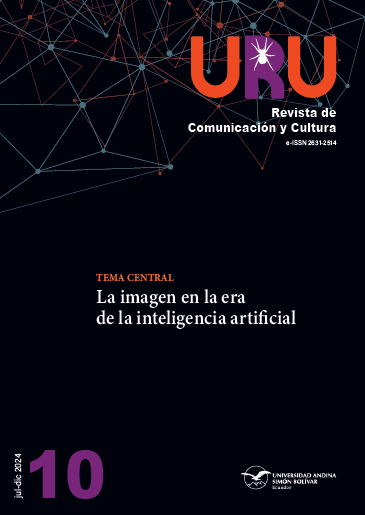Affects in Self-Perception Associated with the Use of Artificial Intelligence
DOI:
https://doi.org/10.32719/26312514.2024.10.2Keywords:
Self-perception, artificial intelligence, self-esteem, image, perception, identityAbstract
Self-perception refers to how we see ourselves, how we perceive ourselves both physically and emotionally. Self-perception is a fundamental part of our identity and plays an important role in well-being and self-esteem. The technology behind artificial intelligence has advanced in leaps and bounds in recent years, especially in the field of facial recognition and image generation, transforming the way we see ourselves and how we interact with others in the virtual world. Currently, machine learning algorithms have the ability to analyze millions of data in an image and recreate it with great precision, this has prompted the creation of applications and programs that allow people to create their own virtual images indistinguishable from real photographs. This article explores the technological advances linked to image modification and the implications of its use: on the one hand, it can help people explore and experiment with different appearances and expressions of themselves, a useful and attractive fact for those who They want to change their physical appearance or feel more comfortable with their body. It can also be a valuable tool for those who suffer from low self-esteem or body image problems, as they can use technology to create an image of themselves that makes them feel more confident and satisfied, but also increases the risks of disapproval in others. areas of self-perception and denial of personal identity
Downloads
References
Arias, Fidias. 2012. El proyecto de investigación: Introducción a la metodología científica. Caracas: Episteme.
Bravo, Verónica, Graciela Fajardo, Wilson Carrión y Linda Salvatierra. 2022. “Transformando la educación virtual: La revolución de la inteligencia artificial en la potenciación de la plataforma Moodle”. Journal of Science and Research 7 (3), 140-64. https://tinyurl.com/27d9pbd6.
Colorado, Óscar. 2023. “Video: ¿Desapareceremos los fotógrafos por la inteligencia artificial?”. Óscar en Fotos. 28 de septiembre. https://tinyurl.com/bde4r2eh.
Felman, Marcelo. 2020. “Estrategia digital para una plataforma B2B de servicios de inteligencia artificial”. Tesis de maestría, Universidad de Chile. https://tinyurl.com/mpna9ddh.
Goetz, Judith, y LeCompte, Margaret. 1988. Etnografía y diseño cualitativo en investigación educativa. Madrid: Morata.
Goodfellow, Ian, Jean Pouget-Abadie, Mehdi Mirza, Bing Xu, David Warde-Farley, Sherjil Ozair, Aaron Courville y Yoshua Bengio. 2014. “Generative Adversarial Networks”. Departement d’Informatique et de Recherche Opérationnelle. Université de Montréal. https://tinyurl.com/yrszxt8w.
Khanna, Anisha, y Manoj Kumar Sharma. 2017. “Selfie Use: The Implications for Psychopathology Expression of Body Dysmorphic Disorder”. Industrial Psychiatry Journal 26 (1): 106-9. https://doi.org/10.4103%2Fipj.ipj_58_17. DOI: https://doi.org/10.4103/ipj.ipj_58_17
Luna, Fernando. 2016. Desarrollo web para dispositivos móviles: Herramientas para diseñar y programar web apps. Buenos Aires: RedUSERS.
Montag, Christian, y Jon Elhai. 2019. “A New Agenda for Personality Psychology in the Digital Age?”. Personality and Individual Differences 147: 128-34. https://tinyurl.com/5n8tj8ja. DOI: https://doi.org/10.1016/j.paid.2019.03.045
Nai, Leonardo. 2020. “Análisis del diseño editorial del Nuevo Diario (El diario chiquito) de Salta”. Tesis de grado, Universidad Católica de Salta, Argentina. https://tinyurl.com/kphxm3fa.
Niño, Víctor. 2019. Metodología de la Investigación. Bogotá: Ediciones de la U.Pedrero, Luis, y Ana Pérez. 2021. “Democracia y digitalización: Implicaciones éticas de la IA en la personalización de contenidos a través de interfaces de voz”. Recerca. Revista pe Pensament i Anàlisi 26
(2). https://doi.org/10.6035/recerca.4666. DOI: https://doi.org/10.6035/recerca.4666
Porcelli, Adriana. 2020. “La inteligencia artificial y la robótica: Sus dilemas sociales, éticos y jurídicos”. Derecho global. Estudios sobre derecho y justicia 6 (16): 49-105. https://doi.org/10.32870/dgedj.v6i16.286. DOI: https://doi.org/10.32870/dgedj.v6i16.286
Ramos, Juanjo. 2015. Instagram para empresas. s/c: s/e. Edición en ebook.
Ramos Galarza, Carlos. 2020. “Los alcances de una investigación”. CienciAmérica. Revista de Divulgación Científica de la Universidad Tecnológica Indoamérica 9 (3). https://tinyurl.com/5n7famve. DOI: https://doi.org/10.33210/ca.v9i3.336
Ruiz, Puri. 2022. “Dismorfia del selfi: Cuando te comparas con imágenes retocadas o distorsionadas por filtros”. Universitat Oberta de Catalunya. 17 de agosto. https://tinyurl.com/34f68w62.
Ryan-Mosley, Tate. 2021. “Los filtros perpetúan el colorismo y uniformizan la belleza”. MIT Technology Review. 23 de agosto. https://tinyurl.com/3449sb6n.
Siibak, Andra. 2009. “Constructing the Self through the Photo Selection: Visual Impression Management on Social Network Websites”. Cyberpshychology. Journal of Psychosocial Research on Cyberspace 3 (1). https://tinyurl.com/z468creh.
Solaguren, María. 2023. “Los filtros de Instagram tienen efectos en nuestra salud mental”. Psicología Amorebieta. 9 de febrero. https://tinyurl.com/mumzbfmc. UNESCO. 2017. “SIESUE Español”. UNESCO. https://tinyurl.com/3k8efb73.
Valbuena, Angélica. 2023. “Elementos psicosociales en la conformación de la personalidad en la cultura de redes sociales”. Revista Ocronos 6 (3). https://tinyurl.com/y767a3s8.
Vázquez, Karelia. 2023. “‘Mirar tu verdadera cara en un espejo de repente te espanta’: Por qué los filtros dañan la salud física y mental”. El País. 30 de marzo. https://tinyurl.com/yvvt5h6u.
Willingham, AJ. 2018. “Los filtros de redes sociales afectan tu percepción”. CNN. 10 de agosto. https://tinyurl.com/48cnnh8j.
Published
How to Cite
Issue
Section
License
Copyright (c) 2024 Uru: Revista de Comunicación y Cultura

This work is licensed under a Creative Commons Attribution-NonCommercial-ShareAlike 4.0 International License.
ASSIGNMENT OF RIGHTS, DECLARATION OF CONFLICT OF INTEREST AND DISSEMINATION
The authors who publish in this journal accept the following conditions:
- Authors retain copyright and grant the journal the right of first publication, with the work registered under the Creative Commons Attribution-NonCommercial-ShareAlike 4.0 License, which allows sharing, adapting and attributing the work (see: Open Access Policies).
- Authors can make other independent and additional contractual agreements for the distribution of the article published in this journal (e.g., include it in an institutional repository or publish it in a book) as long as they expressly indicate that the article was published for the first time in Uru: Revista de Comunicación y Cultura. In the case of reproduction, a note similar to the following must be included: This text was originally published in the journal Uru: Revista de Comunicación y Cultura N ° -, year of publication.
- Authors are encouraged to publish their work on the Internet (e.g. on institutional or personal pages) in the final version published by Uru: Revista de Comunicaicón y Cultura as it may lead to a wider and faster dissemination of the published work.








